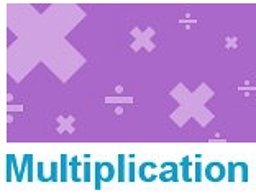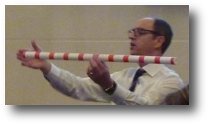Opportunities to practice and use the multiplication tables should arise in every two-week unit. It could be a warm-up starter activity or it could be part of your chosen context with connections made to the main maths focus. It could also be a problem or investigation involves using multiplication facts. The secret to practising and using multiplication facts is to plan for these opportunities, make it fun and keep it fresh.
There needs to be a positive 'can do!' approach to learning multiplication facts. Some children enjoy timed speed tests, but for many more it is the thing that turns them off maths - the pressure and fear of getting it wrong. So where possible try not to place children under pressure to answer instantly, especially to the whole class. Even adults will answer incorrectly in these circumstances - as many politicians know!
So speed isn't everything, but children need to practice the quick recall of facts once they have learnt them. To help with this, build up a bank of resources to use in a variety of ways with the class.
So speed isn't everything, but children need to practice the quick recall of facts once they have learnt them. To help with this, build up a bank of resources to use in a variety of ways with the class.
Use a Counting Stick
Don't forget the old favourite - the counting stick. Use a large counting stick with 10 markers, point to your far right (left for the class) and call it zero and continue along each marker to represent each number in a given times table, in order. It is useful to hold the stick on the centre marker - to show the midway point.
Ask the class to answer together as you point along the stick in order a few times. Then point to the markers, backwards in order. Start at the end and half way markers, then go to the x4, x6 and x9 position, go from these positions to the next number on or back. Repeat these small steps backwards and forwards so they get a mental image of the positions. This way children learn to use the tables facts they know to help with other table facts.
This is a great way to give small, quick bursts to remind children of their times tables. Children reply in unison so there is no individual pressure to answer correctly - children will naturally join in as soon as they have mastered the pattern.
Number Card Snap - working in pairs
You need two piles of shuffled number cards – one with numbers from the times table you wish the children to practise. These groups work well together [2, 5, 10] [2, 5, 3, 4] [3, 6, 4, 8,] [6, 7, 8, 9]. You may need two or three of each number. For the other pile use all the number cards 0-10, or 0-12. Don’t miss out the zero, its good to remind children that 3 x 0 = 0.
Each child turns over a card from a pile at the same time. They take turns to multiply the numbers together and say the answer aloud. If the answer is the same as the previous one they call 'SNAP!' and win a point. Ask them to keep a tally of their score. You can either have a time set and turn over and shuffle each pile, or see the scores at the end of piles and then start a new game.
Can they improve on their last score?
Cover Up Grids
Each child has a 9-square grid and will need 9 counters. (Download the grids template and photocopy).
They enter numbers you have chosen, or with experience children can choose their own numbers to write in the grid. This will involve them using reasoning skills to choose multiples with many different factors, to increase their chance of an answer coming up. To focus on particular times tables, you could restrict the numbers to multiples of 3 & 4 or 7 & 8 up to either x10 or x12.
Ask questions for them to cover the squares on the grid. The first child to get 3 in row gets 1 point, 4 corners 2 points and a full house is 3 points.
‘Cover a number that is a multiple of 9’
‘Cover up 3 multiplied by 7’
'Cover 4 times 9'
Outline of the 2014 changes for multiplication
• The new 2014 National Curriculum takes multiplication up to 12 x 12 rather than only 10 x 10.
• Multiplication tables are introduced earlier, with x 8 in Y3 and all tables up to 12 x 12 by Y4.
• Written multiplication using a single formal written method will be first introduced in Y3 rather than Y4.
• Children are expected to be able to multiply together three numbers mentally in Y4 and also multiply 3-digit numbers using a formal method.
• Y5 includes multiplying a 4-digit number by a 2-digit number, with long multiplication for 2-digit numbers.
• In Y6 there is a greater emphasis on using a single formal written method of long multiplication.
• The new 2014 National Curriculum takes multiplication up to 12 x 12 rather than only 10 x 10.
• Multiplication tables are introduced earlier, with x 8 in Y3 and all tables up to 12 x 12 by Y4.
• Written multiplication using a single formal written method will be first introduced in Y3 rather than Y4.
• Children are expected to be able to multiply together three numbers mentally in Y4 and also multiply 3-digit numbers using a formal method.
• Y5 includes multiplying a 4-digit number by a 2-digit number, with long multiplication for 2-digit numbers.
• In Y6 there is a greater emphasis on using a single formal written method of long multiplication.
A quick daily way to learn a multiplication fact
Play Enter with the passcode. Place a post-it note or card stuck above the door with a multiplication fact such as 6 x 7 written on it. As children walk into the classroom (or leave), they must say 'six sevens are 42'. If you do this with a different fact every day for 2 weeks you can cover all the 6 times table.
Once they have heard this 30 times - you would hope it would stay in the memory!
Setting multiplication practice in context
You can ask children to make up their own maths stories using multiplication.
• Football Maths
There are 11 players in a team, how many in 5 teams?
There are 7 pairs of boots to clean – how many boots in total?
Footballs are sold in bags of 4 (or 3, 6, 7, 8, any table you wish). How many balls in 20 bags?
Football tickets are £50 for adults and £30 for children. A family card for 2 adults and 3 children costs £180. Which is cheapest? (Again change the costs to suit your maths objective).
• Shopping/towns/food - multi-packs of shopping,
Tins of beans are in packs of 4 - how many in 5 packs?
There are 6 eggs in a box, how many in 7 boxes?
Sit in a circle and play 'I went into town and put in my bag 3 multipacks of juice with 4 cartons in each pack' The next person continues with the answer and the next question '...I went to the shop with 12 cartons of orange juice and 2 bags with 8 apples in each.'
Related articles
Using Flip-Flops to practice the multiplication tales
A great resource to download and use.
Helping children learn their tables
Download the multiplication triangles (trios) worksheet
Calculating with negative numbers
Take a look at this way of representing the multiplication of negative numbers
Using Flip-Flops to practice the multiplication tales
A great resource to download and use.
Helping children learn their tables
Download the multiplication triangles (trios) worksheet
Calculating with negative numbers
Take a look at this way of representing the multiplication of negative numbers





